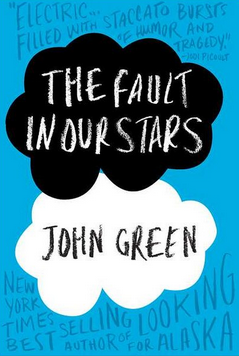I teach this wonderful elective at Year 9 called ‘Language of our Times’. It’s wonderful, because I’ve had the freedom to create the curriculum. The premise behind the subject is that we are studying how we communicate in today’s world. So far this year my students have explored the art of presenting well by creating Pecha Kucha presentations (and been supported by the generous Garr Reynolds in the process) and have looked at the way John Green uses social media platforms to grow his audience and support his career as an author.
I thought that sharing a task I set my class to do might be helpful to people out there who are teaching English and perhaps thinking about how they might incorporate something that recognises what might be required if you are intending to write in online spaces.
THE TASK!
Write a Feature Article for an Online Newspaper.
Your focus: John Green and the methods he employs to build his audience.
But first….you need to do some research.
I have created a page in iVE (our LMS) with links to articles about John Green and online videos where John is discussing his life (amongst other things). To do all of this reading and viewing is very time consuming but necessary if you are going to understand your subject matter in depth.
So….you are going to pool your talent and work in groups to do the research. In your group you will need to divvy up the reading and viewing. I would like you to create a shared Google Doc (that you file in the Language of our Times folder in your Google Drive) where you will be identifying what source you have read and writing notes that are visible to all in the group to ensure you come to a shared understanding of John Green and all he does.
Writing the feature article – transmedia article (text, pictures and video)
Necessary elements:
Effective Headline
An inviting lead that draws the reader into the article
Hyperlinks to source material
An embedded video
Suitable pictures that complement the text
References to experts, use of quotes to support claims being made.
A well structured piece of writing that follows conventions for online newspaper publishing (we’ll be looking at exemplar models in class to assist your understanding of what this looks like)
An effective conclusion.
Minimum word length: 750 words
The students did require exemplar models to gain an understanding of the structure of an online news article. While we we working on this task, John Green was heavily involved on promotion for the film of ‘The Fault in our Stars’, so there was plenty to provide as models, like this one here. They really needed to see what a good lead looked like and the nature of writing for online audiences where the paragraphs are often very short and sometimes even just one line.
Quite a bit like blogging really.
I think this is so important to teach our young people. Schools (particularly English classes) tend to get tied up in the mire of the five paragraph essay, when in real life, no one in their right mind is ever going to stick to such a pre-determined structure. Well, not me, anyway.
Demonstrating how to hyperlink text is a skill that often needs to be taught. I’ve written about this in the past. When I went through this with the students, I could hear the ‘aaahhhs’ around the room as they discovered the mystery of hyperlinked text. Who, I ask, is teaching this skill, and how many teachers out there even know how to do it? I’ve shown plenty in my time. Surely this is something that is a fundamental skill in today’s day and age?
I had the students write their article in Google Docs so that I could give them feedback through Hapara Teacher Dashboard (another post I need to write!). This enables me to shoot into their Docs quickly and makes the feedback loop between them and me really fast. One of the features lacking in Google Docs at the moment is the ability to embed a video so the students had to take screenshots of a YouTube video and provide the link.
I do have to say, the quality of the work submitted was pretty high. I was genuinely blown away by the headlines and leads the students came up with. One student had five different headlines written in the planning stages and all surpassed many I had seen in the exemplars we had looked at.
I’ve asked one of my students, Emma, if I could share her piece here. She’s agreed, so take a read yourself and see if you think this piece is as good as I think it is. I’m pretty darn impressed that a Year 9 student is capable of producing a piece at at this standard.
John Green, the Internet Community Puppeteer
John Green
If you are one of the small minorities that aren’t familiar with the name ‘John Green’, you won’t remain that way for long. From humble beginnings, this Indiana-based author has become one of the most successful people on the Internet. Using his large fan base “Nerd fighters” he has made his way to become a young adult bestseller novelist, a famous YouTuber and earned his place on the Time’s list of the most 100 influential people in the world.
As the internet continues to be of larger importance in modern day society, more and more time is being spent in this virtual space. John Green suggested humorously that we should “Just move to the Internet, its great [there]. We get to live inside where the weather is always awesome.” But this is becoming increasingly true, especially amongst the younger generations. John Green has managed to become very influential online, hence reaching out to a larger audience than ever possible before the 21th century. A single “tweet” on his twitter recommending a book can cause the sales to boom the same day. Critics have dubbed this phenomenon the “John Green Bump”.
But how did he become so influential?
His road to fame probably began during project “Brotherhood 2.0”; one of the first vital points in John Green’s Internet take over. In 2007 he and his brother Hank agreed to only communicate through YouTube as a medium. From January the 1 until the 31st of December, the two brothers took turns uploading videos to their YouTube channel, “VlogBrothers” every weekday. The videos had varied content. It usually had the brothers talking about their lives and things that genuinely matter to them while lacing in jokes and trying to make each other laugh. From this project they not only entertained each other but also a large audience that was later dubbed “Nerdfighters”. Currently this channel has over 2 million subscribers alone.
The Nerdfighters are supposedly “made up of awesome”. They are John Green’s loyal army of extremely active fans (some who are well known youtubers themselves). John Green enjoys being a self-proclaimed nerd, “…because nerds like us are allowed to be ironically enthusiastic about stuff… Nerds are allowed to love stuff, like jump-and-down-in-the chair-can’t-control-yourself love it.” And John Green’s ever-abundant Nerdfighters do exactly that. They nerd over and love everything to do with John Green: his merchandise, his books, his videos, his words and him. As a result their influence in the online space is of colossal proportions due to their sheer enormity. They promote John Green and what he does, further spreading his influence amongst the online community, for free.
John Green at a fan meeting
As well as managing the “Vlogbrothers” channel, John Green also produces “CrashCourse,” an educational YouTube channel, where he educates his audience in 12 minutes about world history, psychology, biology, ecology, literature and chemistry. Using humour and entertaining visuals, he makes his lessons more fun and educational. These 12-minute clips are easy to fit within classes or study periods and making them a convenient tool for teachers. His indirect presence further expands his audience as he is introduced to a younger generation of consumers through the internet-savvy teachers.
John Green also puts his dominance on the web to good use for the less fortunate. Using his extensive Internet presence he created “ProjectforAwesome”, (also known as P4A) an event that occurs for two days (traditionally Dec 18-19) annually where YouTubers raise money for a charity of their choice by promoting it to their audience. In 2013 they successfully raised $869,171. That is almost double the amount they raised the year previously, suggesting that his audience has grown considerably larger in just a year.
As an author, John Green wrote the young-adult best sellers, “Looking for Alaska”, “Paper Towns” and the immensely popular “The Fault in Our Stars (TFiOS)” which has been converted into a major feature film adaptation. This tearjerker is rare amongst young adult fiction because it is a cancer book, where the main protagonist is a cancer patient. The book received highly positive reviews with critics such as the New York Times describing the book as “”a blend of melancholy, sweet, philosophical and funny” and that it “stays the course of tragic realism”. Upon release of the book, it stayed as number one bestseller list for 44 weeks and had 150,000 pre-orders (which John Green kindly hand signed each copy diligently).
John Green’s bestseller, “Fault in Our Stars”
But what has made John and his works so successful?
The answer probably comes down to a combination of free, his endorsements, thanks to his fan base, and the fact that people generally really like it. The proof? Well, the average rating is 4.52 out of five, on goodreads.com, which is very high in comparison to most books (e.g. “Perks of Being a Wallflower” average rating is 4.2). The book was also voted as one of the winners of Goodreads choice Awards 2012 and the winner of Children’s Choice Book Awards for Teen Book of the Year. The readers obviously also seemed to have liked it enough to recommend it to their friends and family. John Green suspects that another factor leading to the books success is the fact that his “readers are evangelists.”
The people who read his books tend to be incredibly devoted fans who want to convert everyone they possibly can into Nerdfighters or at least, a fan of TFiOS, filling up posts and comments with fan art, gifs quoting the novel and screaming pleas for people to read the book. John Green could not ask for a better audience.
Such an audience isn’t to be taken for granted. John Green puts a lot of effort into connecting with his fans. He asks them for their opinion and seems generally curious. He somehow miraculously manages and is active on a vast variety of social media platforms including YouTube, Twitter, tumblr, Facebook, Goodreads, subbable (a sharing platform which he and his brother Hank founded), his own blog and instagram. He sends out surveys to gather data do that he can shape his activities to suit his audience and gauge which social media platform seem to attract the most visitors and how they found out about him in the first place. He calls this survey, “Nerdfighteria Census”. He also arranges fan-meet ups and gatherings so that he can meet his fans and help them to feel closer as a community.
His audience is attracted to his humble, likeable and witty personality, making him an idealistic role model. He believes in self-acceptance, accepting other people and fighting for the right to be who you want to be. He “… tr[ies] to live life so that [he] can live with [him]self.”
Watch a video from his youtube channel Vlogbrothers, “What To Do With Your Life”:
John Green has set a high standard for role models everywhere. His presence on the Internet, as vast and extensive as it is, is not just beneficial for him. It is also beneficial to a lot of people who are influenced by him, those who would like to aspire to become someone like him and also to become someone like themselves. Marketers and authors who wish to promote themselves should also look to John Green for his good use of social media platforms and connecting with his fans. John Green is also looked up to by those who can relate to him and just want to also remind each other DFTBA (Don’t forget to be awesome); borrowing John Green’s catchphrase as both a greeting, farewell and encouragement.
I was impressed. I hope you were too.
What did I do wrong?
I didn’t get my students to create a bibliography and properly cite the sources they had used. Massive oversight being a Teacher-Librarian by trade and all. Something I will need to rectify next time.
I wish I could share all of my student’s work. The time they invested into this task was impressive and I’m sure they learnt skills that might not be being covered elsewhere. I’m loving the opportunity to explore interesting curriculum and teach my students skills and content that I think are important in today’s world.




![Reblog this post [with Zemanta]](https://i0.wp.com/img.zemanta.com/reblog_e.png)